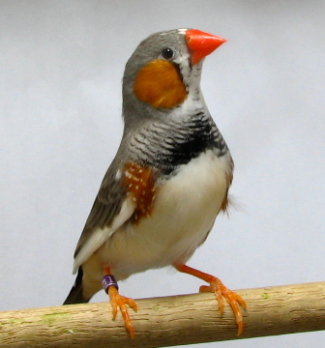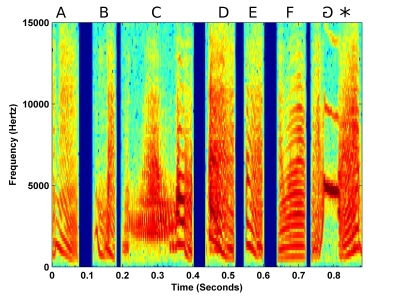Beth Vernaleo (bgoldman@umd.edu)
Robert Dooling (dooling@psyc.umd.edu)
University of Maryland
Neuroscience and Cognitive Science Program,
Dept. of Psychology
College Park, MD 20742
Popular version of paper 4pAB10
Presented Thursday Afternoon, November 13 th, 2008
150 th ASA Meeting, Miami, FL
Songbirds provide a useful model for vocal learning and animal communication. Most research has focused on how birds learn and produce song.
Less is known about how birds perceive their own songs and the songs of others.
In many songbird species, male birds sing to attract females and to defend their territories from other males. The zebra finch is an interesting case in which these birds sing only one song, which they sing for their entire lifetime. Once these songs have been learned, they do not change regardless of how many new songs a zebra finch may encounter. These songs are sung in a very consistent manner, and there is little variation from rendition to rendition.

Songs consist of brief bursts of sound (syllables) separated by silence (intervals). Each syllable is unique in its acoustic properties. Each syllable and interval in a song has a specific duration that is consistent from song to song. Below is a spectrogram of a motif, which is a specific ordering of syllables that is repeated over and over to form the song. The syllables are labeled as A, B, C, D, E, F, and G.

In my experiments, I am testing whether zebra finches can detect changes made to their song motifs, and what types of changes are most easily detected. I am specifically making two types of changes: increases to the duration of single intervals, and reversals of single syllables. By doubling the length of silence between two syllables in a motif, a change is being made to the overall rhythm and timing of song. In reversing a single syllable, the syllable is flipped in time, and is basically played backwards to the bird. For many syllables this results in a very different sound. However, for syllables that are symmetric, the change is less dramatic. The spectrograms below are examples of the target motifs birds must discriminate from the original unchanged motif. The first one shows a doubling of the first interval, and the second one shows a reversal of the last syllable (marked by asterisks). These can be compared to the first motif shown. For each target motif, only a single change is made.


The testing setup consists of a cage that has two light emitting diodes (red and green LEDs) placed on the wall. There is also a speaker overhead through which sounds are played to the bird. The original song motif is played as a repeating background, and the bird must peck the left (red) LED as this motif is being played. At random times, a changed motif is played to the bird instead of the original motif. If the bird detects a change from the original motif, he must peck the right (green) LED. If he does so correctly, he receives a food reward. If he does not detect a change, then he must remain pecking the left LED. By recording which keys the bird pecks during the changed motifs, we can determine which changes the bird can detect, how quickly he can detect these changes, and which changes the bird seems unable to detect. Below is a video showing the experimental setup, and a bird completing this task.
This type of task is called a discrimination task, because birds must discriminate between two different sounds. When birds are first trained to peck the LEDs, this training is very general, and birds can detect changes in pitch, loudness, and duration of simple sounds such as tones. Once birds are tested on more complex sounds such as song, it appears that there may be some changes they are unable to detect.
The results of my experiments suggest that zebra finches are quite good at discriminating syllable reversals, but are poor at discriminating changes to interval lengths. Data for one experiment is shown below. The x-axis shows the target motifs that the birds had to discriminate from the original motif. Int1, Int4, and Int6 are motifs in which the first, fourth, or sixth interval was doubled in length. A-rev, C-rev, E-rev, and G-rev are motifs in which syllable A, C, E, or G was reversed. The y-axis shows discrimination performance, which is measured in percent correct. As seen in the graph, discrimination performance was much higher for single syllable reversals than for single interval doublings.
